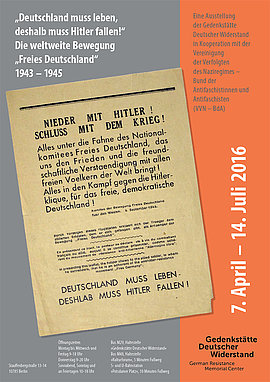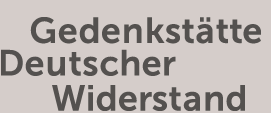German Resistance Memorial Center Exhibition
"Germany must live, therefore Hitler must fall!" The Worldwide "Free Germany Movement," 1943 to 1945
A German Resistance Memorial Center exhibition in cooperation with the Vereinigung der Verfolgten des Naziregimes - Bund der Antifaschistinnen und Antifaschisten (VVN-BdA)
In the winter of 1942/43, Hitler sacrificed twenty-two divisions through his command to hold out at Stalingrad. More than 100,000 German soldiers fell, froze, or starved to death even before the surrender of the Sixth Army. Over 90,000 men ended up in Soviet prisoner-of-war camps—only around 6,000 of them survived.
In July 1943, German communist emigrants and prisoners of war founded the National Committee “Free Germany” (NKFD) in Krasnogorsk camp near Moscow, on the initiative of the Soviet leadership. The committee called on Wehrmacht soldiers to refuse obedience to Hitler. In September 1943, a number of the German generals captured at Stalingrad also decided to fight the Nazi regime. Their Federation of German Officers (BDO) was amalgamated with the NKFD shortly after its foundation.
In its founding manifesto, the National Committee drew on attempts in the 1930s to form a popular front and sought to address opponents of the regime of different origins and political orientations.
As early as February 1942, the Latin American Committee of Free Germans was founded in Mexico, initiated by German communists as a nonpartisan and nondenominational organization. After the founding of the NKFD in the Soviet Union, further nonpartisan groupings of German exiles formed in various European countries, Latin America, and the United States, mainly as a result of communist initiatives.
They supported the goals of the NKFD and informed the general public in their host countries about the situation in Germany. By means of flyers, lectures, and their own publications, they called for an end to the Nazi regime and worked toward democratic renewal in Germany.
The political conditions and scope for action were very different in each country. The Free Germany Movement for the West, formed in France in the fall of 1943, became an official part of the French Resistance in April 1944. The governments of Sweden and Switzerland insisted on their countries’ neutrality and banned refugees from taking part in any political activities. In January 1944, German exiles formed the Free German League of Culture in Sweden. The Free Germany movement in Switzerland was finally granted official permission in March 1945.
The exhibition opening took place on Thursday, April 7, 2016, at 7 pm in the German Resistance Memorial Center, Stauffenbergstraße 13-14, 10785 Berlin, second floor, hall B.
The exhibition is on display in the special exhibition area on the first floor until September 14, 2016.
Opening hours
Mon-Wed, Fri 9 a.m. to 6 p.m.
Thurs 9 a.m. to 8 p.m.
Sat, Sun and public holidays 10 a.m. to 6 p.m.
We reserve the right to make changes. Information by telephone: +49 (0)30-26 99 50 00.


